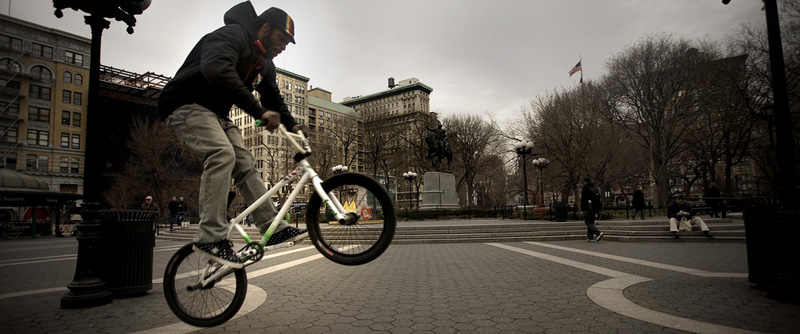BACK TO THE STREETS
When Rone started riding, BMX was an alien presence in Flatbush. “At first I never saw or thought that black people rode, so I figured, yeah, it was a white boy sport,” Williams said. He recalls older kids at Erasmus Hall High School calling him a white boy because he wore skate shoes, not Nikes. “They’d say, ‘Oh what’s up, Tony Hawk?’”
But as he and his friends came of age, BMX arrived with them—not just in Flatbush, but in neighborhoods all over New York City that had never seen a BMX bike before. Originating in the suburbs of Southern California, skateboarding and BMX, which started off as a bicycle racing sport, were understood, universally, to be white pursuits, for grungy adolescents who listened to punk rock.
It was only a matter of time before skateboarding and BMX broke the color line. Hip-hop, skateboarding, and BMX are inclusive cultures, dedicated to individualism. Riders and skaters achieve personally targeted goals and prove their abilities on their own terms. In that, the sports are very much like hip hop, where rappers compete to prove their prowess. Skate and BMX, which are banned in many public places, also offer the outlaw cachet so central to hip hop.
“If you skateboarded through the projects two years ago, the kids would laugh at you,” said Steve Rodriguez, who owns the skateboarding company 5 Boro. “If you skate through now they want to skate with you.”
One of the first skateboarders to make it big in hip hop was Pharrell Williams, part of the duo, N.E.R.D., that starred Rone in their smutty music video. Pharrell Williams started his skate team Ice Cream in 2005, and a chunk of its riders are black. That same year Snoop Dogg started Snoop Dogg Skate Company, selling a complete line of skate board products. Rapper Red Man has a clothing shop on Staten Island that sells a variety of skateboarding and BMX gear, including many products from Rone Williams’ sponsor, Animal.
Sensing a new, untapped market, skate and BMX companies started using hip hop, music videos, and MTV shows to promote gear and apparel. The Sporting Good Manufacturers Association estimates that the number of skateboarders in the U.S. has doubled over the last five years (compare that to a mere 12 percent rise for basketball and 4 percent in football.) The Skate Park Association of America claims that approximately one million freestyle bike riders are out there jumping, grinding and shredding.
As skateboarding and BMX started showing up in largely black and Latino urban neighborhoods, many skateboarding companies began to assemble multiracial teams of skaters. The hip hop/skateboarding alliance went mainstream in 2006, with “Kick-Push,” from hip-hop artist and former skateboarder Lupe Fiasco. The music video for “Kick-Push” featured black and white skateboarders riding together. Fiasco’s lyrics resonate with the city’s new generation of skate kids:
“Labeled a misfit, a bandit/His neighbors couldn’t stand it so. He was banished to the park. Started in the morning wouldn’t stop ’til after dark. Yea, when they said, “It’s getting late in here… so I’m sorry young man there’s no skating here”
Skate parks provide a rare space where skaters and BMXers can ride free of harassment from cops. “I see every race at the skate park: Latino, Asian, Black, White, they’re all there,” says BMX rider Ed Pollio, 26. “It’s a good thing.”
Pollio first got to know Rone Williams a decade ago, when riders from all over New York’s boroughs rode the ferry to Staten Island and converged in an abandoned lot on Edgewater Street in Rosebank to ride makeshift ramps made out of stolen wood. “Tyrone came to the Rosebank ramps from with kids from Brooklyn, the Bronx,” Pollio remembers. “They come ride here because at the time the only trails were in Long Island and at Mullaly’s.
“Back then all little kids like Tyrone and me were heading down bad roads. We veered away from it because of bike riding,” continues Pollio, who, with another BMX rider, Tom Grunwald, petitioned Borough Parks Commissioner Thomas Paulo the city to build Staten Island’s first skate park, which opened in Midland Beach in 2003.
The Ben Soto Skate Park is free for all skateboarders and BMX riders under the age of 18. “I realized thanks to Tom and Ed and kids in love with the sport that its something that kids love to do and want to do and there was no where to do it,” says Staten Island Borough Parks Commissioner Thomas Paulo. “Kids travel around the country to try out different skate parks. They’re devoted to it.” Paulo only expects interest in BMX to grow. In 2008, the sport made its Olympics debut in Beijing, with Latvia and France taking home the men’s and women’s gold.

